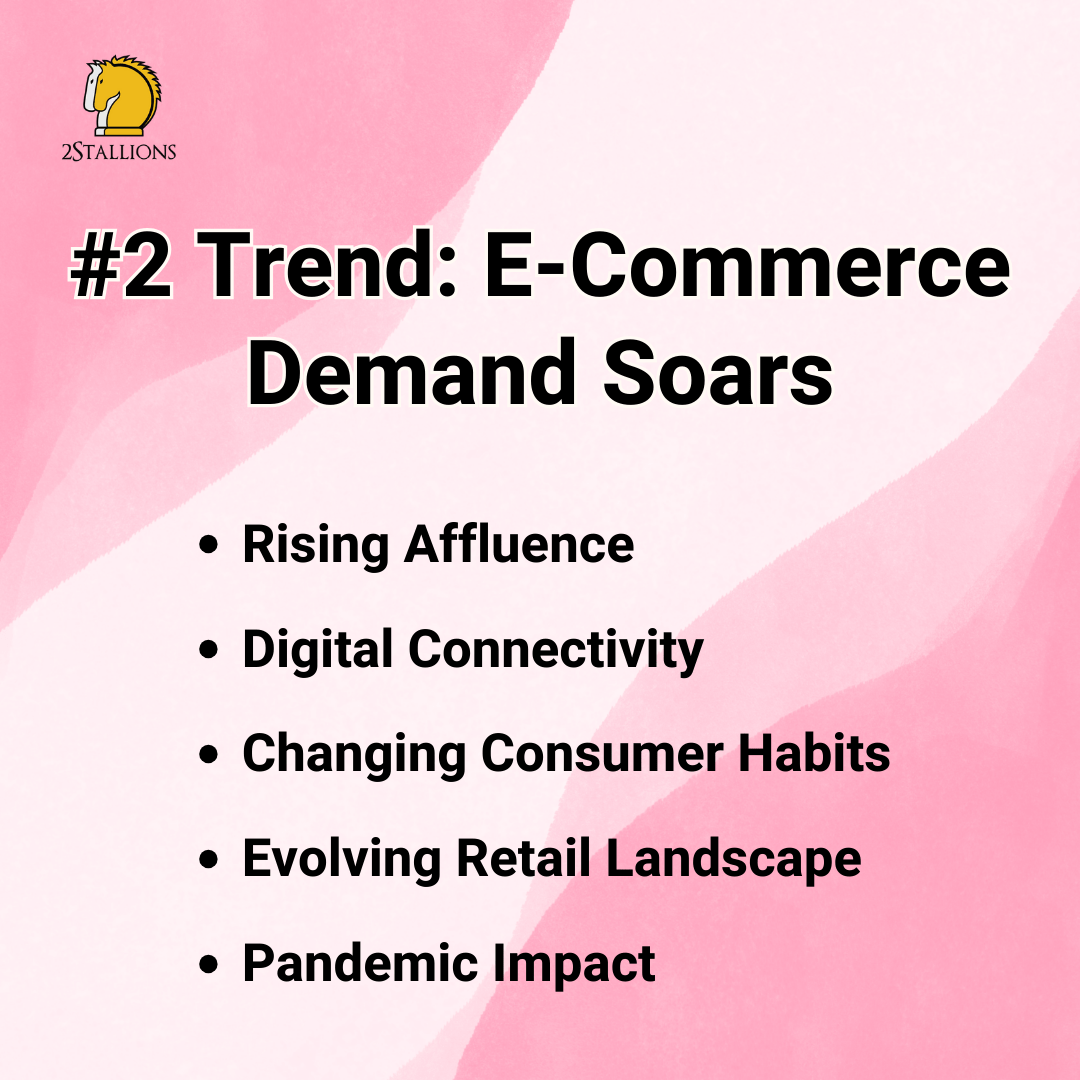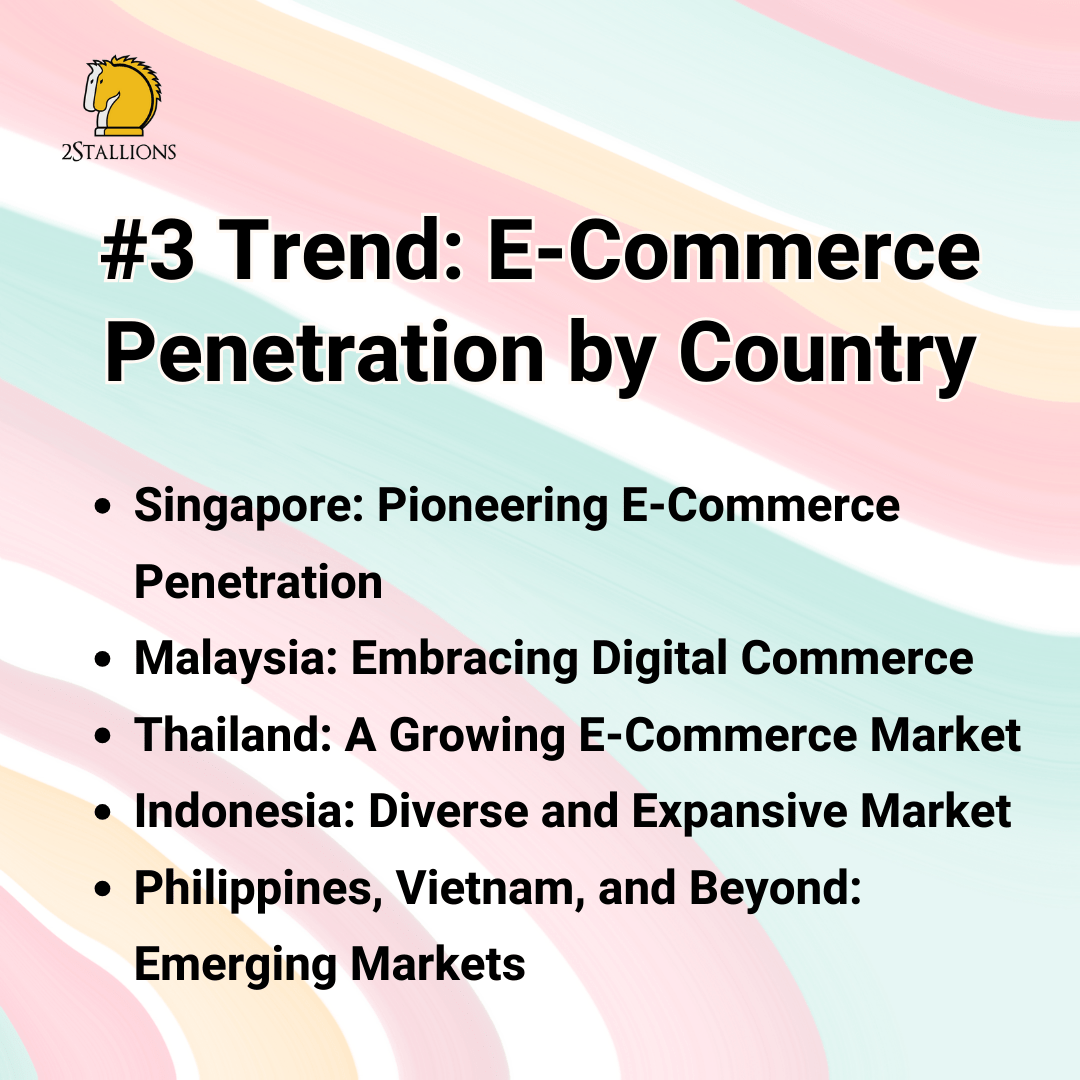SHARE

In the dynamic landscape of Southeast Asia (SEA), businesses are continually adapting to evolving consumer behaviours and market trends. Keeping a keen eye on the latest developments is crucial to staying ahead in the highly competitive eCommerce industry. This article will explore 3 eCommerce Trends in SEA that can be leveraged to boost your business.

#1 Trend: Southeast Asian Models
In the realm of SEA eCommerce, one of the defining characteristics that entrepreneurs and businesses need to comprehend is the multitude of Southeast Asian models that shape the digital marketplace. These models play a pivotal role in determining the region’s eCommerce demand and penetration by country, making it crucial to decipher their nuances.
Marketplace Diversity
Southeast Asia is not a uniform market; it’s an amalgamation of distinct nations, each with its unique eCommerce landscape. While names like Lazada and Shopee dominate in some countries, platforms like Tokopedia and Bukalapak lead the way in others. Understanding these marketplaces is essential for success in SEA eCommerce. Tailoring your business model to fit the specific marketplace dynamics can significantly impact your reach and success.
[thrive_leads id=’8310′]
Consumer Preferences
The region’s diverse cultures, languages, and consumer behaviours further contribute to the complexity of Southeast Asian models. Recognising and respecting these nuances is critical to capturing the hearts of local consumers. By aligning your eCommerce approach with the preferences of each country, you can harness the tremendous eCommerce demand inherent in the Southeast Asian market.
Adaptation and Expansion
Businesses that can adapt to the unique models of Southeast Asia are well-positioned to explore the potential. The varying eCommerce penetration by country presents both challenges and opportunities. While markets like Singapore and Malaysia have high penetration rates, others are rapidly catching up. Identifying these distinctions allows businesses to prioritise their efforts and tailor strategies for success.

#2 Trend: eCommerce Demand Soars
In Southeast Asian eCommerce, one prominent trend is the soaring demand for online shopping. This surge in order is a testament to the region’s evolving consumer behaviours and the growing impact of digitalisation. Here’s a closer look at why eCommerce demand is reaching new heights in Southeast Asia:
Rising Affluence
As economies across Southeast Asia continue to grow, disposable incomes are rising. This increase in affluence empowers more people to participate in eCommerce activities, from online shopping to digital payments. Customers now have more spending power, contributing to the demand upswing.
Digital Connectivity
Southeast Asia is experiencing a digital revolution, with more people gaining access to the internet and smartphones. This improved connectivity enables individuals from urban and rural areas to engage in eCommerce. The convenience of shopping from mobile devices has fueled eCommerce demand, making it a central part of people’s daily lives.
Changing Consumer Habits
Consumers are increasingly gravitating toward the convenience and variety that eCommerce platforms offer. The ability to shop from home, access a wide range of products, and benefit from seamless delivery options has shifted consumer habits. This transformation in behaviour is propelling the eCommerce industry forward.
Evolving Retail Landscape
Traditional retail is adapting to the changing times by expanding its online presence. Brick-and-mortar businesses are embracing eCommerce to remain competitive. This shift caters to existing online shoppers and introduces new consumers to the world of digital commerce.
Pandemic Impact
The COVID-19 pandemic accelerated the digital shift as people turned to online shopping for safety and convenience. This event further ingrained eCommerce as an integral part of consumers’ lives, and many have continued to shop online even as restrictions to physical and ground shopping have eased.

#3 Trend: eCommerce Penetration by Country
One of the key aspects that sets the Southeast Asian eCommerce landscape apart is the varying degrees of eCommerce penetration by country. Each nation in the region has its unique characteristics and challenges, making it essential for businesses to understand these differences to capitalise on the growing SEA eCommerce market. Let’s take a closer look at the variations and opportunities within Southeast Asia:
Singapore: Pioneering eCommerce Penetration
Singapore is the frontrunner in eCommerce penetration in Southeast Asia. With a highly developed digital infrastructure and high consumer affluence, eCommerce has become integral to daily life. Businesses aiming to establish a presence in Southeast Asia often start here due to the well-established eCommerce ecosystem.
Malaysia: Embracing Digital Commerce
Malaysia also boasts a significant level of e-commerce penetration. The country’s robust digital connectivity and increasing adoption of online shopping make it an attractive market for businesses. Local eCommerce platforms and international brands find ample opportunities to thrive in this dynamic environment.
Thailand: A Growing eCommerce Market
Thailand is witnessing a surge in eCommerce adoption, driven by the increasing digital literacy of its population. eCommerce demand is on the rise, creating a promising landscape for businesses. Understanding the local preferences and adapting strategies can unlock opportunities in this evolving market.
Indonesia: Diverse and Expansive Market
With its vast population, Indonesia represents both a challenge and an opportunity. eCommerce models here vary, from the dominant marketplace players like Tokopedia and Bukalapak to a rising interest in social commerce. Exploring these diverse models is essential to tap into the immense potential of this market.
Philippines, Vietnam, and Beyond: Emerging Markets
Countries like the Philippines and Vietnam are considered emerging markets regarding eCommerce penetration. While the adoption of digital commerce is gradually increasing, there is still significant room for growth. Businesses entering these markets should be prepared to adapt their strategies to the local conditions and consumer behaviours.
How To Keep Up With This Trend?
To effectively keep up with the ever-evolving trends in Southeast Asian eCommerce, you need a strategic approach that ensures your business remains agile and competitive. Here’s a step-by-step guide on how to stay ahead of the curve:
1. Research and Analysis:
Stay informed by continuously monitoring the region’s latest developments and market data. Regularly review reports, studies, and industry publications highlighting emerging trends, consumer behaviour, and market dynamics. Pay special attention to data on Southeast Asian models, eCommerce demand, and eCommerce penetration by country, as these are the key focus areas.
2. Engage with Local Influencers:
As Southeast Asian models gain prominence, it’s essential to establish connections with them. Collaborate with local influencers and models who resonate with your target audience. Their insights and reach can be invaluable in building a solid online presence and connecting with consumers. Please make use of social media and influencer marketing to harness their influence.
3. Adapt Your eCommerce Strategy:
eCommerce demand is rising, so ensure your online store is optimised for user experience and mobile devices. Continuously update your product offerings and services to meet evolving consumer needs. Incorporate user-friendly features, such as easy navigation and secure payment options, to enhance the shopping experience.
4. Market Segmentation:
Understanding eCommerce penetration rates by country is critical. Tailor your marketing and sales strategies to cater to each market’s unique characteristics. Conduct market research and identify consumer preferences and behaviours specific to your target countries. This will help you create tailored marketing campaigns and adapt your product offerings accordingly.
5. Agility and Flexibility:
In the rapidly changing eCommerce landscape, agility is a crucial asset. Be ready to pivot your strategies when needed. This might involve quick adjustments to pricing, promotions, or marketing channels. Adapting swiftly to changing market conditions is crucial for staying competitive.
6. Network and Collaborate:
Build strong relationships with other businesses in the industry. Collaborate with partners, suppliers, and industry associations to share insights and stay updated on best practices. Networking can provide valuable information and access to resources to help you keep up with the trends.
7. Customer Feedback and Surveys:
Engage with your customers through feedback and surveys. Gather insights into their changing preferences and expectations. This direct feedback loop will help you fine-tune your eCommerce strategies and ensure you’re meeting customer demands effectively.
8. Continuous Learning:
Invest in your team’s knowledge and skills. Encourage them to attend relevant workshops, webinars, and conferences. eCommerce is dynamic, and ongoing education is vital to remain competitive.
9. Technology Integration:
Embrace technological advancements that can enhance your eCommerce operations. Explore innovations like artificial intelligence, machine learning, and data analytics to gain a competitive edge in understanding consumer behaviour and streamlining your processes.
10. Measure and Adapt:
Regularly assess the impact of your strategies and campaigns. Use analytics tools to track your progress, and be ready to make changes based on performance data. Continuously refining your approach is essential for long-term success.
Are you primed to ignite a powerful online presence? Our E-commerce Development Services are not only captivate and inspire your audience but also propel them to take action. Let us be your partners in achieving online excellence through cutting-edge technology. Set your digital presence ablaze and lead the revolution today!
Originally published: 28 September 2020
Updated: 6 November 2023
Frequently Asked Questions about eCommerce Trends in SEA
What are the significant trends of eCommerce in the world?
Several significant trends in the global eCommerce landscape are reshaping how businesses and consumers interact. Omnichannel shopping is a pivotal trend, offering a seamless experience across online and offline channels. Mobile commerce continues to thrive, with businesses optimising their websites and apps for mobile users.
Sustainability and ethical shopping practices are rising, focusing on eco-friendly products and transparent supply chains. Artificial intelligence plays a crucial role in personalising customer experiences. Subscription-based models and AR/VR technologies are gaining popularity, offering convenience and immersive shopping experiences. eCommerce marketplaces like Amazon and Alibaba continue to dominate the global eCommerce landscape.
What is one of the biggest trends in eCommerce?
The “Buy Now, Pay Later” (BNPL) trend is among the most significant eCommerce trends. BNPL services allow customers to make purchases and pay them in instalments, often without interest charges.
This trend offers payment flexibility and appeals to a broad audience, bridging the gap between traditional credit options and immediate payment methods. BNPL services are changing how people shop and pay for products online, making high-value and discretionary purchases more accessible.
What is the trend in eCommerce in APAC?
In the Asia-Pacific (APAC) region, cross-border eCommerce is rising, reflecting global integration and consumers’ interest in diverse products. Mobile commerce dominates due to high smartphone penetration, leading to tailored strategies for mobile users.
Digital wallets, live commerce, and the emergence of “super apps” are prominent trends. Digital wallets like Alipay and WeChat Pay streamline payment processes. Live commerce utilises live streaming for real-time engagement and product promotion. “Super apps” offer multiple services beyond ride-hailing and food delivery, including eCommerce and financial services, creating versatile user hubs.
What are the trends in eCommerce in 2023?
Anticipated eCommerce trends in 2023 include sustainability initiatives, focusing on eco-friendly products and carbon-neutral shipping. Voice commerce, driven by voice-activated devices, is expected to grow. Niche marketplaces catering to specific interests will emerge, offering specialised product selections.
Extended reality (XR) technologies like augmented reality (AR) and virtual reality (VR) will enhance the shopping experience. Blockchain adoption for transparent supply chains and secure transactions is likely to increase. Innovations in last-mile delivery, including drones and autonomous vehicles, will make the delivery process more efficient and eco-friendly, shaping the e-commerce landscape in 2023.





